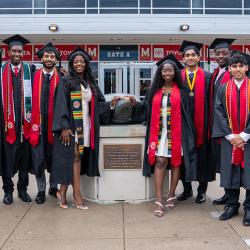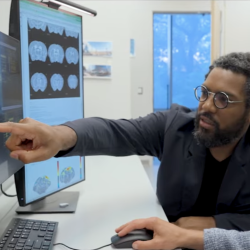Exploring the Secret Lives of Figs and Fig Wasps
UMD Biology Professor Carlos Machado studies the extraordinary partnership between figs and their tiny pollinators—and what happens when some evolutionary partners turn into ‘cheaters.’

If you’ve ever bitten into a fresh fig, you’ve tasted the delicious result of one of nature’s most extraordinary and longstanding partnerships. But the figs in your local grocery store only tell a small part of the tale.
Wild figs, the ancestors of the domesticated and non-pollinating fruits commonly consumed today, harbor a secret world invisible to the naked eye. Hidden within the fig is an entire ecosystem built around a partnership so ancient and intricate that it’s been shaping life on Earth for over 70 million years—a relationship that Carlos Machado, a professor of biology at the University of Maryland, has spent years traveling around the world to study.
“Figs are central to the maintenance of diversity in tropical forests because they produce fruit year-round,” Machado said. “Their constant ability to provide food and support for animals makes them vital for the survival and reproduction of many species. In return, animals that consume figs disperse the fruit seeds, which helps to establish and maintain new fig populations and contribute to overall forest diversity.”
A core component of this complex ecosystem is the fig wasp, an insect tinier than a sesame seed. Despite its diminutive size, the wasp and its mating habits play a large role in supporting entire ecological systems.
“A fig ‘fruit’ is actually an enclosed flower cluster containing hundreds of tiny flowers hidden inside. The flowers can’t be pollinated by wind or other insects; they’re completely dependent on host specific wasp partners,” Machado explained. “And wasps are equally dependent on figs for a place to reproduce.”
Partners through life and death

Adult female fig wasps live only one to two days, and during that time, they must find a fig tree in a specific stage of development. Guided by chemical signals the fig releases, these tiny insects—often carried by wind currents—may travel long distances, sometimes over 100 miles, to find the right target.
After a female wasp locates a receptive fig, she forces her way inside through a nearly sealed opening in the fruit, sometimes losing her wings and antennae in the process. Once inside, the female fig wasp pollinates the fig flowers while laying her eggs in some of them. Over the next few weeks, the eggs develop into larvae and the offspring mate with each other inside the fig. Wingless male fig wasps use their powerful mandibles to chew a hole through the fig wall before dying inside the fruit, allowing the winged females to escape and carry pollen to other figs to start the cycle over again.
To accomplish these extreme feats, fig wasps evolved extremely specialized structures on their bodies, according to Machado. For example, the insects evolved ‘pollen pockets’ in their abdomens and unique combs on their legs for collecting and storing fig pollen. Some fig wasp species even developed flattened heads to better squeeze through tight fig openings.
“The fig-wasp relationship represents one of nature’s best examples of mutual dependence. They have changed themselves to adapt to each other, giving and taking from each other,” Machado said. “This partnership has been evolving for millions of years.”
When partners become ‘cheaters’
But this seemingly perfect partnership isn’t always flawless. Some wasps have gradually evolved to become ‘cheaters,’—entering figs and laying eggs without providing pollination in return.
In most cases, fig trees evolved to punish these freeloaders by dropping unpollinated figs onto the ground, ensuring that cheating wasps don’t survive to reproduce and that they don’t invest resources on them. However, Machado’s research team in collaboration with Chinese colleagues have been studying the remarkable case of two wasp species that evolved to become full-time cheaters, losing their pollen-carrying structures entirely.
“These wasps never carry pollen, and they don’t have pollen pockets,” Machado noted. “They have become exclusively non-pollinating.”
This discovery has provided Machado and his research team with a unique natural experiment for understanding how evolutionary partnerships change over time and what prevents them from breaking down.

“Our findings suggest that when natural selection pressure is relaxed, species can rapidly lose complex physical structures and even behaviors they previously evolved,” Machado explained. “Without punishments from the figs, the cheating wasps can survive. This not only changes the dynamics of the fig-wasp relationship but also its impact on the ecosystem they’re a part of.”
Using cutting-edge genomic tools, Machado’s team has also uncovered other surprising patterns in how figs and wasps evolved worldwide. For example, fig species do not strictly co-evolve with an specific wasp partner. Instead, genetic data revealed frequent ‘host-switching’—wasps occasionally jumping to a new fig species, sometimes displacing the original fig wasp completely. Although host-switching can sometimes disrupt coevolved partnerships, it can also lead to the generation of increased genetic diversity in the host figs.
More recently, Machado’s group has also found that nearly half of the genetic material of a fig wasp from Central America is organized in unusual regions dense with ‘jumping genes,’ genetic elements that can move around the genome and play a major role in evolution. According to Machado, this unusual arrangement of genetic material could cause different evolutionary patterns within the same organism’s genome, leading to insights into how genomic composition affects evolution.
Ancient partnerships facing modern challenges
Machado believes that the historical relationship between the fig and fig wasp will transform yet again as weather patterns become more extreme and habitat fragmentation increases. With new pressures threatening the delicate balance between the two partners, their longtime cooperation may be disrupted—impacting the biodiversity and survival of ecosystems around the world.
“It’s a growing concern,” Machado said. “While the wasps’ ability to travel might be able to help them maintain genetic diversity across fragmented landscapes, the expansion of invasive fig species northward can also disrupt native ecosystems. Some introduced fig species in Florida are already considered pests, with ‘strangler fig’ growth patterns potentially overwhelming native trees. Studying the fig-wasp relationship reminds us that some of the most important things in nature occur on scales almost too small to see, but their effects ripple through entire ecosystems—keeping tropical forests alive and thriving for millions of species, including our own.”







